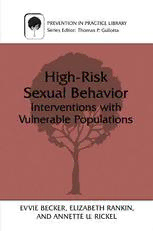Table Of ContentHigh-Risl< Sexual Behavior
Interventions with Vulnerable Populations
PREVENTION IN PRACTICE LIBRARY
SERIES EDITOR
Thomas P. Gullotta
Child and Family Agency, New London, Connecticut
ADVISORY BOARD
George W. Albee, University of Vermont
Evvie Becker, University of Connecticut
Martin Bloom, University of Connecticut
Emory Cowen, University of Rochester
Roger Weissberg, University of Illinois
Joseph Zins, University of Cindnnatl
HIGH-RISK SEXUAL BEHAVIOR:
Interventions with Vulnerable Populations
Ewle Becker, Elizabeth Rankin, and Annette U. Rickel
REDUCING THE RISKS FOR SUBSTANCE ABUSE:
A Lifespan Approach
Raymond P. Daugherty and Carl Leukefeld
SUCCESSFUL AGING: Strategies for Healthy Living
Waldo C. Klein and MartIn Bloom
TYPE A BEHAVIOR: ITS DIAGNOSIS AND TREATMENT
Meyer Friedman
High-Risl< Sexual Behavior
Interventions with Vulnerable Populations
Ewie Becker
Elizabeth Rankin
University of Connecticut
Storrs, Connecticut
and
Annette U. Rickel
Georgetown University Medical Center
Washington, D.C.
Springer Science+ Business Media, LLC
Library of Congress Cataloging-in-Publication Data
On file
ISBN 978-0-306-45858-3 ISBN 978-1-4899-0107-1 (eBook)
DOI 10.1007/978-1-4899-0107-1
© 1998 Springer Science+Business Media New York
Originally published by Plenum Press, New York in 1998
10987654321
All rights reserved
No part of this book may be reproduced, stored in a retrieval system, or transmitted in any
form or by any means, electronic, mechanical, photocopying, microfilming, recording, or
otherwise, without written permission from the Publisher
Preface
In this volume, we describe how sexual behavior puts individuals at
risk for a myriad of negative consequences, from sexually transmitted
diseases, such as AIDS, to unwanted pregnancy. The consequences of
these adverse outcomes for society as a whole are enormous, including
the fiscal burden of health care costs, as well as the vicious cycle put
in motion by teen pregnancy, lack of education, poverty, and the
intergenerational transmission of this downward spiral. Specific inter
ventions are described in each chapter, with attention to the needs of
especially vulnerable populations.
In Chapter I, the relationship between high-risk sexual behavior
and its potential negative consequences is described. Specifically,
various sexually transmitted diseases (STDs) are discussed, including
HIV infection and AIDS, as well as less life-threatening but still
dangerous STDs such as chlamydia, gonorrhea, and genital herpes.
Teen pregnancy is examined in light of the cycle created by lack of
opportunity, lack of education, and poverty. Consequences of un
wanted pregnancy beyond the teen years are also noted, including the
risks of child maltreatment for unwanted children.
In the second chapter, we describe some of the mediators and
moderators of high-risk sexual behavior, including psychological fac
tors, use of alcohol and other drugs, risk awareness, poverty, and a
history of childhood maltreatment.
Models of prevention are discussed in Chapter 3, including gen
eral theoretical models of how humans change behavior, as well as
specific models for changing high-risk sexual behavior. Tests of these
models, along with specific prevention programs, are described.
v
vi Preface
Chapter 4 reviews the literature on ethnicity and social class
considerations related to high-risk sexual behavior. Guidelines are
suggested based on current research findings related to ethnic differ
ences and socioeconomic factors. Alcohol and other drug use is also
discussed in this context.
In Chapter 5, women's unique risks are discussed. Partner intimi
dation and/or violence, alcohol and other drug use, rape, history of
abuse in childhood, psychological consequences of abortion, risk from
partner's injected drug use, and transmission of HIV from mother to
child are among the issues addressed.
Chapter 6 describes guidelines for intervention with gay men,
outlining findings of research and prevention efforts with the gay
community, as well as intervention and treatment of gay men with
AIDS and their partners. Issues of grief and loss in the gay community
are also addressed.
In writing this volume, we envisioned a world where prevention
of sexual risk is the norm, and individuals make choices that enhance
their lives and the lives of those with whom they are intimate. Like B.F.
Skinner, we imagine a world where all individuals "are adequately
clothed, fed, cared for, respected, able to make important choices, able
to grow, able to learn, and able to love" (Biglan, 1993, p. 4). We are
committed to finding ways to create such a world.
This work is dedicated to that vision.
Evvie Becker
Elizabeth Rankin
Annette Rickel
Acknowledgments
We would like to give special thanks to our research assistants,
Jennifer Ganter and Manuel Morales, for their excellent support. We
would also like to express our appreciation to the Department of
Psychology at the University of Connecticut for providing us with the
resources and support to complete this work. Finally, we are especially
grateful to our series editor, Tom Gullotta, for his thorough reading of
the manuscript and his perceptive comments, and to Mariclaire Clou
tier of Plenum Press, for her editorial expertise in completing this
project.
vii
Contents
Chapter 1. What's at Stake: Consequences of Risky Sexual
Behavior ................................... .
Chapter 2. Factors that Influence Sexual Behavior: Causes,
Mediators, and Moderators of High-Risk Sexual
Behavior .................................... 31
Chapter 3. Models of Prevention . . . . . . . . . . . . . . . . . . . . . . . . .. 51
Chapter 4. Guidelines for Prevention, I: Ethnicity and Social
Class Considerations .......................... 79
Chapter 5. Guidelines for Intervention, II: Women ........... 101
Chapter 6. Guidelines for Intervention, III: Gay Men and
Bisexuals .................................... 121
Epilogue . . . . . . . . . . . . . . . . . . . . . . . . . . . . . . . . . . . . . . . . . . . . .. 143
References ............................................ 145
Index ................................................. 163
ix
High-Risl< Sexual Behavior
Interventions with Vulnerable Populations

